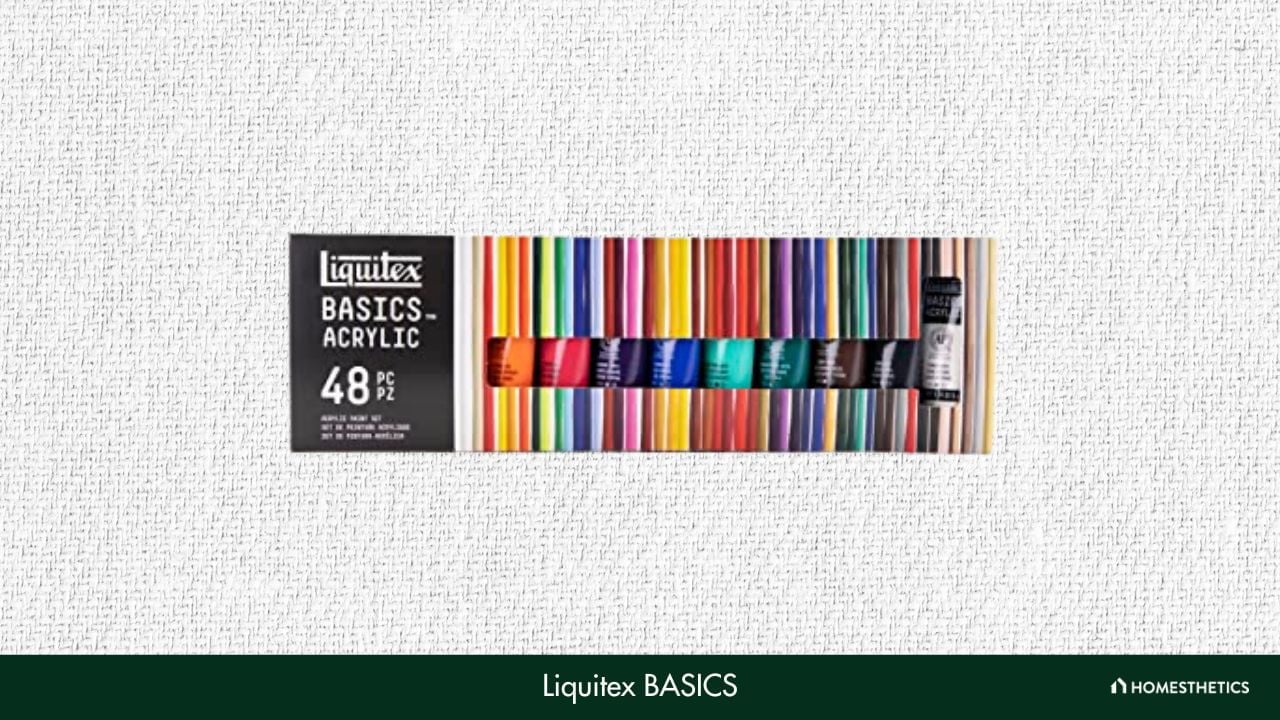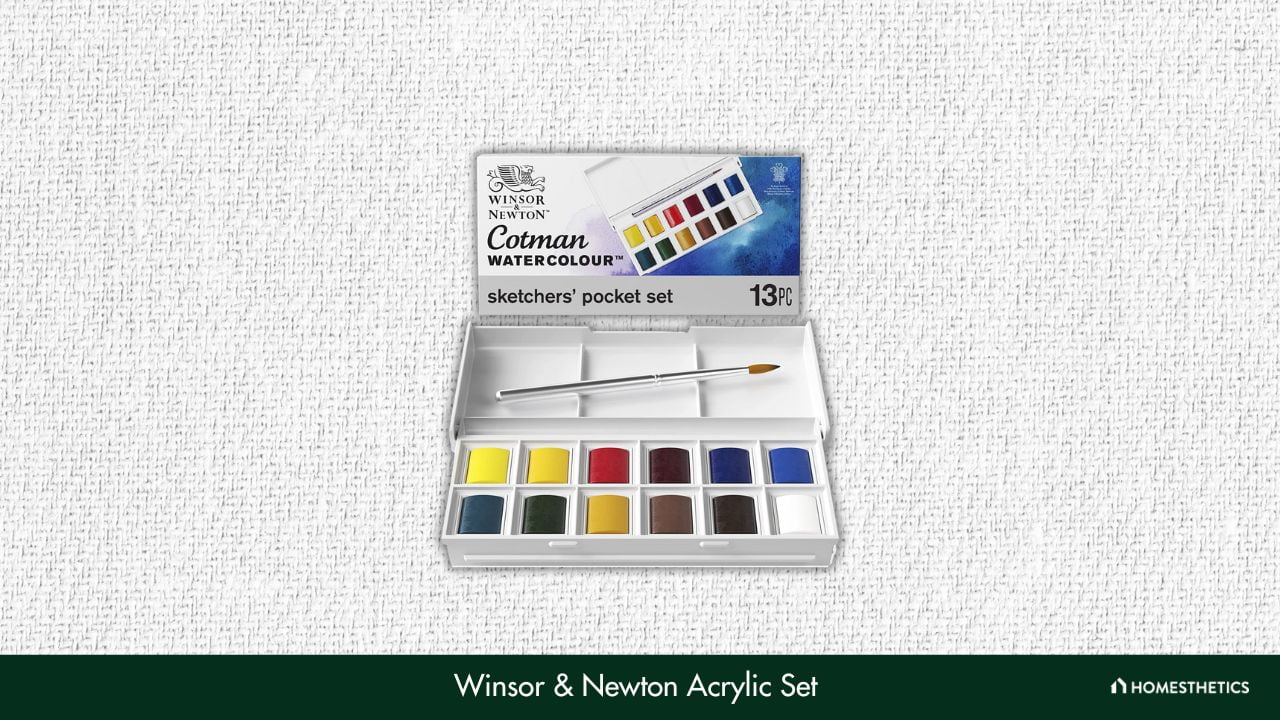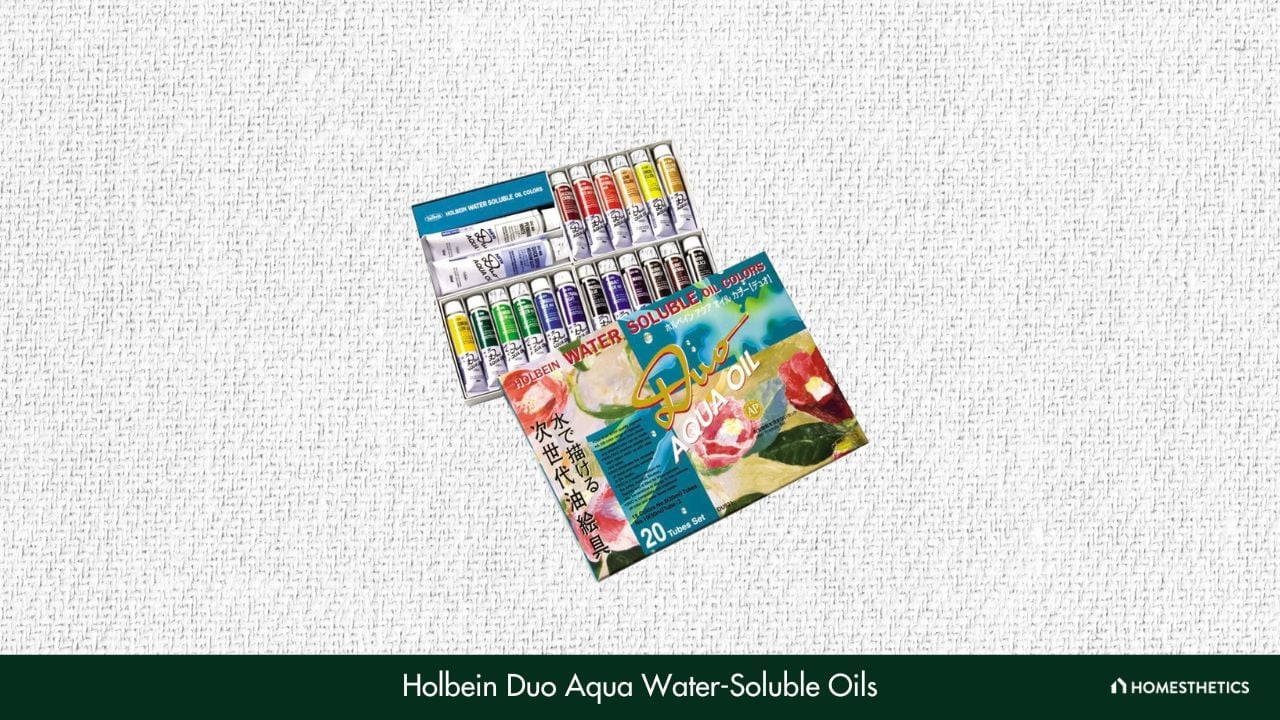 Reviewed by
Anton Giuroiu
Reviewed by
Anton Giuroiu
Painting is a fantastic hobby that I have pursued in my leisure for years now. It is a productive way to vent my emotions and creativity.

I started painting on canvases about 4 years ago. Now, I have given up my sketchbooks just because of the experience I get on a canvas.
But paint behaves very differently on canvases and to many these mediums may be new as well.
Therefore, it’s extremely important to get the right paint for the job. You may already know that acrylic paint and oil paint work on canvas. But it can be confusing to choose the right medium for yourself.
So, here are some paints that I have fallen in love with over the years, the best paints for canvas are here!
Listed below are the 5 best Paints for Canvas from our list:
-
Liquitex BASICS Paints for Canvases: Distinguished for providing a budget-friendly painting option for beginners with impressive color stickiness and mixability.
-
Winsor & Newton Acrylic Set for Canvas Painting: Stands out for its consistent performance on canvas, bright colors, and excellent color retention, rendering it perfect for multilayered painting.
-
Golden Open Acrylics: Recognized for its slower drying time akin to oil paints, making it an excellent choice for detailed works and touch-ups that require more time.
-
Old Holland Classic Oil: Esteemed for its historical brand value, these paints provide the best experience with high-quality pigments, impressive lightfastness, and long-lasting nature, making it a favorite among professionals.
-
Holbein Duo Aqua Water-Soluble Oils: Celebrated for their high industry standards and water-soluble nature, these oil paints provide vivid colors and a healthier painting experience by eliminating harmful chemicals associated with most oil paints.
From traditional oil paints to modern acrylics, we have got you covered. So, without further ado, here's the list of the 5 best paints for canvas.
-
Liquitex BASICS Paints for Canvases - Best For Beginners
If you are getting started with painting and want to keep the budget on down low this is your best bet.
I used this acrylic paint set for quite some time when I started and still use it from time to time for my side projects. The reason is that this budget variant doesn’t make too many compromises in quality to achieve the price tag.
The color sticks well to the canvas and is viscous. What I love the most about it is that it also mixes well with other colors and mediums which gives me the modularity to get specific colors while painting.
But keep in mind that you’ll have to experiment quite a bit for it because the pigments don’t mix as expected all the time.
Unlike other cheap variants, this acrylic paint works incredibly well in layers and even when it’s thinned out with water, it sticks to the canvas well.
Due to its consistency, it sticks excellently with brushes. I use white horsehair flat brushes for most of the painting and I am amazed at how well it all works out. It functioned well with nylon paintbrushes as well.
For a beginner, I don’t think there is any better option in the acrylic paint market. It sticks well to canvas, works fabulously in layers, and sticks well to brushes. All you have to get used to is mixing colors on palettes. That’s more of a problem for veterans than for newcomers in my humble opinion. But even as an experienced individual, I have no complaints about this paint.
-
Winsor & Newton Acrylic Set for Canvas Painting - Best For Professionals On A Budget
This paint satisfies everyone’s needs even though it’s harder on the wallet than the previous entry.
Winsor & Newton has been a part of my acrylic paint set for a long time because I love how consistently it performs on canvas. The colors are strong and bright and work fantastically when mixed as well.
The color retains incredibly well on canvas which is great for multilayered painting. The pigments are of great quality and I am astounded that it’s as good as some of my oil colors. It totally justifies its price.
Even though it’s meant for more experienced and serious artists because of its price and quality, I’d recommend it to beginners as well because it reduces the steepness of the learning curve of painting - especially, on canvas.
The colors are very clean, behave truly on canvas, and it has a certain satin texture. That may not work with some art styles but artists around the world admire the finish of acrylic paints. Even I do.
It comes with 10 colors and it’s enough to create most other colors, especially because the color mixes so well and accurately. One gripe I do have is that this paint is softer than my liking. If it grinds your gears as well, I’ll advise getting some texture paste for medium. In my experience, it’s the most straightforward solution to the problem.
Even though this set is meant for students, I think this is well suited for professional use as well. The consistency and the grip leave no room for asking for more. I see this set as a budget option for professionals. It can very well be used for any side or personal project.
-
Golden Open Acrylics - Best For Detailed Works
This paint set is great for working on shades. It works great for softening, blending, and shading as it’s clean and bright. I use this for detailed works that most people call a “touch-up”.
Golden Open Acrylics dries more like oil paint - slower and giving you more time to work on it. It is a welcomed attribute because I use this paint for working on dried layers of paint when I need more time to work out the details. That's why I think that adding this paint is so necessary for your arsenal to be complete.
There are eight colors in the set which is enough for creating most colors. The colors blend very well and you can work it to make translucent spreads very easily. The pigments are of great quality as well, providing strong and consistent colors.
Most of the “touch-up” work needs a lot of mixing of colors to make it consistent with your primary application. I found these colors to be excellent for that job as the pigments are of top-notch quality and leave no room for complaint.
I recommend this acrylic paint set for working secondary and tertiary layers only. Mostly for shading, blending, and glazing. The properties these colors have are perfect for that. Now as a beginner, you may skip it. There are way many things to work on before you start perfecting “touch-ups”.
But if you have already been in the game for a while now and are serious about making your artwork more vibrant, then I can’t recommend Golden Open Acrylics more. Especially it works so much like oil paints. It has no comparison.
-
Old Holland Classic Oil
Now we are moving to oil paints. Oil paint is the best way to put your ideas on a canvas. And it’s just not me, many artists and professionals agree as well.
It’s just the way the oil paint blends and behaves on canvas that makes it the perfect experience with the best results.
Old Holland is one of the oldest brands of paint. It was established in the 17th century and has been used by several famous artists, like Van Gogh.
Of course, these colors don’t mess around. Starting from the pigments to the viscosity and consistency, there’s nothing that tops Old Holland in quality and experience.
There are no cheap fillers in this color, all you’ll get is the best pigments for the most accurate colors and consistent spread and behavior. Not only this, these colors don’t lose color and texture over time. In the community, it’s called lightfastness.
Except for Cremnitz White and Madder Lakes, every color is completely lightfast and even these two are almost lightfast as well.
May it be landscapes, still lifes, or figures, there’s nothing you can’t do with these paints as they offer transparent as well as opaque paints with excellent pigments.
These paints also last a lot longer than others as the medium has fantastic tinting strength and although it’s expensive, at least it’ll be quite some time before these run out.
The oil paint stretches quite a lot which not only saves paint but also is easy to paint with and looks more natural and pleasing. As expected, the spread and mixing are fantastic as well, although I’d recommend getting natural hair brushes for the best results. Old Holland deserves the best anyway.
-
Holbein Duo Aqua Water-Soluble Oils
This is the modern-day standard for oil paints. Holbein Duo Aqua Water-Soluble Oils are meant for professional use through and through, and they scream quality in every way possible.
Unlike most oil paints which use linseed oils for spread and turpentine for the wash, these oils are crafted so that it can be used with water as well, as the name suggests.
These colors meet industry standards on every term and undergo rigorous testing procedures, like thermal stability, adhesion, and color tone. It even undergoes bacterial testing.
It even eliminates all the harmful chemicals and toxins that are associated with most oil paints and gives a healthy experience for the modern-day user.
If all of this sounds too scientific and less artistic to you, don’t worry. The paint performs excellently and is worth every penny of its high price tag. The paint is thick and has a beautiful consistency that feels mesmerizing on the first touch of a paintbrush.
The colors are more vivid and expressive than some of the other brands but I don’t see that as a negative trait. In my experience, it brings more life to my creation. It mixes accurately as well and it comes in a variety of colors, so you can go as close as you can get to your imagination.
The color even blends well within different layers and it comes with a dryer solution which, if added, makes the paint dry faster. Perfect for people who don’t want to wait for the oils to dry up. But I, for one, love the wait because in my opinion the color seems more vibrant and blends better when I let it dry naturally.
What is the Best Paint For Canvas?
Outlined below is a comparison table, diligently constructed to highlight the essential qualities of top-tier paints designed for canvas. The table examines each option in terms of paint type, quantity, finish, drying time, and lightfastness, a measure of color durability under light exposure.
| Product | Type of Paint | Quantity | Finish | Drying Time | Lightfastness |
|---|---|---|---|---|---|
| Liquitex BASICS Paints for Canvases | Acrylic | 48 tubes | Matte | 15-30 min | Poor to Good |
| Winsor & Newton Acrylic Set for Canvas Painting | Acrylic | 10 tubes | Matte | 20-30 min | Good to High |
| Golden Open Acrylics | Acrylic | 8 tubes | Matte | 20-30 min | Good to High |
| Old Holland Classic Oil | Oil | 10 tubes | Gloss | 2-12 days | Excellent |
| Holbein Duo Aqua Water-Soluble Oils | Watercolor | 20 tubes | Matte | 20-30 min | Good to High |
Buying Guide for the Best Paints For Canvas
Choosing the right paint for your canvas is crucial for achieving the effect and result you desire in your artwork. To help you make an informed decision, we have compiled a comprehensive buying guide that covers all the important factors you need to consider when purchasing the best paint for your canvas.
1. Type of Paint
There are three main types of paint that work well on canvas: acrylic, oil, and watercolor.
a. Acrylic Paint
Acrylic paints are versatile, quick-drying, and have vibrant colors. They are suitable for various painting techniques and can be used on different surfaces. They are also easier to clean up due to their water-soluble nature.
b. Oil Paint
Oil paints are classically favored by many professional artists. They provide rich, deep colors and allow the painter a longer working time to create details, blend colors, and achieve a specific texture.
c. Watercolor Paint
Watercolors are well-suited for beginners, offering translucency and ease of use. They dry quickly and can be reactivated with water, allowing for corrections and modifications.
2. Quality: Student vs. Artist Grade
Consider the quality of the paints you choose. Student-grade paints are more affordable but may lack pigment concentration, resulting in less vibrant colors. Artist-grade paints are typically more expensive, but they have higher pigment concentrations, better color quality, and improved lightfastness.
3. Pigment Concentration
Higher pigment concentration gives better color coverage and vibrancy. However, it also adds to the price of the paint. Determine the right balance based on your needs and budget.
4. Lightfastness
Lightfastness refers to how well a paint retains its color when exposed to light. Higher lightfastness ratings mean the paint is more resistant to fading and discoloration over time. Ensure you choose paints that have a good lightfastness rating.
5. Drying Time
Drying times vary among different types of paints. Acrylic paint dries the fastest, followed by watercolor, and then oil. Choose the paint type that suits your working style and preferred drying time.
6. Brand Reputation and Reliability
Choose a paint brand that has a good reputation for quality, consistency, and customer support. Some reputable brands include Winsor & Newton, Golden, Liquitex, Gamblin, and Daler-Rowney.
7. Safety and Toxicity
Many paints can be harmful if ingested or inhaled. Be sure to choose paints that comply with safety standards and are labeled as non-toxic. This is especially important if children or pets may come into contact with the materials.
8. Budget
Lastly, consider your budget when purchasing paint for canvas. While it is essential to invest in quality materials, it is also important to be mindful of your spending.
Important Tip: Remember that experimentation is essential in the world of art. Consider trying different paints and brands to find the one that suits your painting style and technique the best. It may take time, but discovering the best paint for canvas will ultimately lead to more fulfilling and enjoyable artistic experiences.
What is the difference between student and artist-grade paints?
Student-grade paints are less expensive and have a lower pigment concentration compared to artist-grade paints. Artist-grade paints are more expensive but have a higher pigment concentration and are of higher quality, making them ideal for professional artists.
How many coats of paint should I apply to a canvas?
The number of coats of paint required on a canvas depends on the opacity and thickness of the paint. It is recommended to apply at least two coats of paint for even coverage and to allow for a more durable finish.
Can I mix different brands of paint on canvas?
Yes, different brands of paint can be mixed on a canvas. However, it is recommended to use the same type of paint (oil or acrylic) to ensure compatibility.
Can I use spray paint on canvas?
Yes, spray paint can be used on canvas, but it is recommended to use a primer to prepare the surface before painting to ensure good adhesion and prevent the paint from soaking through the canvas.
Can I paint on a canvas without stretching it first?
Yes, you can paint on an unstretched canvas, but it is recommended to stretch the canvas first to prevent it from warping or buckling over time.
How long does it take for paint to dry on a canvas?
The drying time of paint on a canvas depends on the type and thickness of the paint, as well as the humidity and temperature of the environment. Acrylic paint dries faster than oil paint and typically takes about 30 minutes to an hour to dry, while oil paint can take up to several days to fully dry.
Thank you for taking the time to read our article on the best paints for canvas! We appreciate your interest and hope the information provided has been helpful and insightful. Now that we have looked at all aspects of the available paint options, it's time for the moment you've been waiting for – our top three expert recommendations.
Out of these 5 best paints for canvas, here are the top three expert recommendations:
-
Best for beginners: Liquitex BASICS Acrylic Paint Set is an ideal option. With budget-friendly pricing and decent quality that doesn't compromise too much on color vibrancy, this set is perfect for those starting their artistic journey or working on side projects.
-
Best for professionals on a budget: Winsor & Newton Acrylic Set is a good option. A trusted brand offering consistent performance, strong and bright colors, and excellent blending abilities make this acrylic set suitable for serious artists, whether they're students or professionals.
-
Best for detailed works: Golden Open Acrylics is the right choice. These paints behave more like oil paints, drying slower and providing more working time, making them excellent for secondary and tertiary shading, blending, and glazing layers.
As you continue to explore the world of canvas painting, remember that practice and exploration are key to finding your unique style and preferences. With these expert recommendations, you should now have a solid starting point to choose the best paints for your needs. Happy painting, and let your creativity flow!





